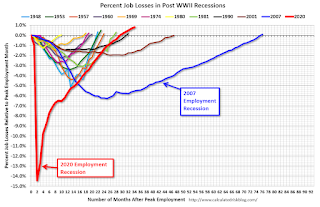by Calculated Risk on 2/02/2023 12:41:00 PM
Thursday, February 02, 2023
January Employment Preview
On Friday at 8:30 AM ET, the BLS will release the employment report for January. The consensus is for 185,000 jobs added, and for the unemployment rate to increase to 3.6%.
From BofA economists:
"Nonfarm payrolls likely rose by 225k in January, little changed from the December increase. Payrolls were likely boosted by the end of the strike by University of California workers in late December. The strike affected 36k workers according to the BLS and likely largely explained the ~24k drop in state education employment in December. These workers should return to payrolls in January."From Goldman Sachs:
"We continue to expect a strong employment report, and we left our nonfarm payroll forecast unchanged at +300k (mom sa)."
 Click on graph for larger image.
Click on graph for larger image.• First, as of December there were 1.24 million more jobs than in February 2020 (the month before the pandemic).
This graph shows the job losses from the start of the employment recession, in percentage terms. As of August 2022, the total number of jobs had returned.
• Annual Benchmark Revision: The benchmark revision for 2021 will be released with the January employment report. The above graph doesn't include the preliminary benchmark revision that showed there were 462 thousand more jobs than originally reported in March 2022.
• ADP Report: The ADP employment report showed 106,000 private sector jobs were added in January. This suggests job gains below consensus expectations. ADP chief economist Nela Richardson noted: "In January, we saw the impact of weather-related disruptions on employment during our reference week. Hiring was stronger during other weeks of the month, in line with the strength we saw late last year."
• ISM Surveys: Note that the ISM indexes are diffusion indexes based on the number of firms hiring (not the number of hires). The ISM® manufacturing employment index decreased in January to 50.6%, down from 50.8% last month. This would suggest the number of manufacturing jobs was mostly unchanged in January.
The ISM® services employment index for January has not been released yet.
• Unemployment Claims: The weekly claims report showed a decrease in the number of initial unemployment claims during the reference week (includes the 12th of the month) from 216,000 in December to 192,000 in January. This would usually suggest fewer layoffs in January than in December. In general, weekly claims were below expectations in January.
• COVID: As far as the pandemic, the number of weekly cases during the reference week in January was around 332,000, down from 458,000 in December.
• Weather: As ADP noted, there was severe weather during the reference week. After the release, I'll check the San Francisco Fed estimate of Weather-Adjusted Change in Total Nonfarm Employment.
• Conclusion: This employment report is especially hard to predict. There is a significant seasonal adjustment for January (there are always a large number of jobs lost in January NSA). And there are other factors - severe weather, end of a strike - that will likely impact hiring. My guess is the report will be below consensus.


